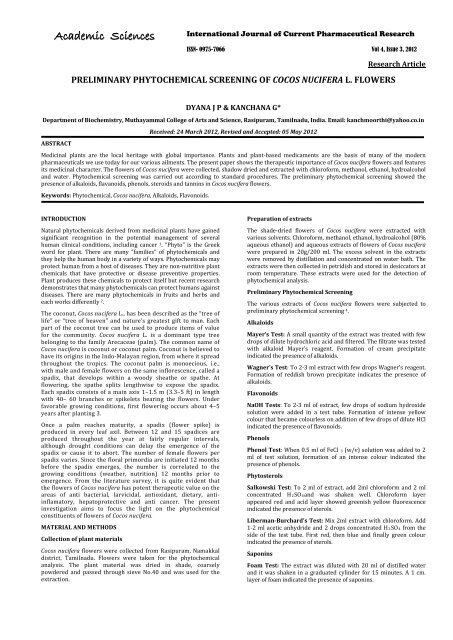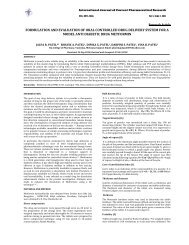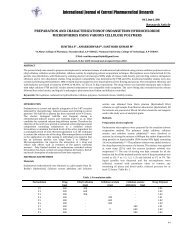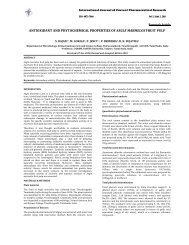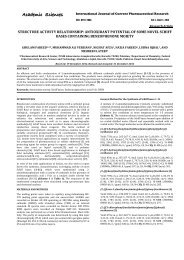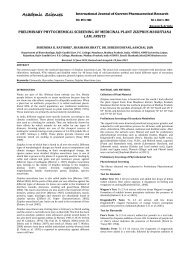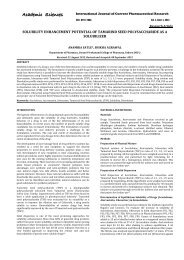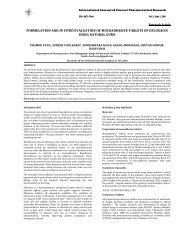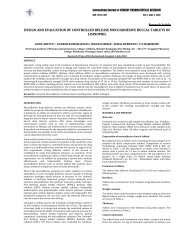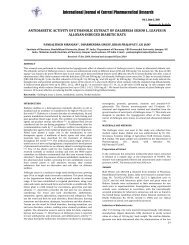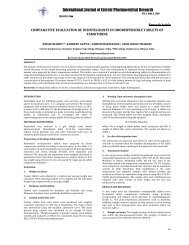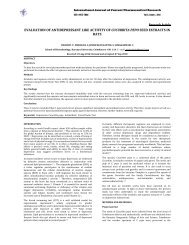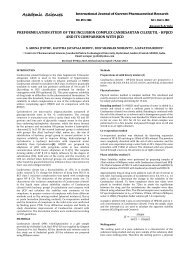preliminary phytochemical screening of cocos nucifera l. flowers
preliminary phytochemical screening of cocos nucifera l. flowers
preliminary phytochemical screening of cocos nucifera l. flowers
Create successful ePaper yourself
Turn your PDF publications into a flip-book with our unique Google optimized e-Paper software.
Academic SciencesInternational Journal <strong>of</strong> Current Pharmaceutical ResearchISSN- 0975-7066 Vol 4, Issue 3, 2012Research ArticlePRELIMINARY PHYTOCHEMICAL SCREENING OF COCOS NUCIFERA L. FLOWERSDYANA J P & KANCHANA G*Department <strong>of</strong> Biochemistry, Muthayammal College <strong>of</strong> Arts and Science, Rasipuram, Tamilnadu, India. Email: kanchmoorthi@yahoo.co.inABSTRACTReceived: 24 March 2012, Revised and Accepted: 05 May 2012Medicinal plants are the local heritage with global importance. Plants and plant-based medicaments are the basis <strong>of</strong> many <strong>of</strong> the modernpharmaceuticals we use today for our various ailments. The present paper shows the therapeutic importance <strong>of</strong> Cocos <strong>nucifera</strong> <strong>flowers</strong> and featuresits medicinal character. The <strong>flowers</strong> <strong>of</strong> Cocos <strong>nucifera</strong> were collected, shadow dried and extracted with chlor<strong>of</strong>orm, methanol, ethanol, hydroalcoholand water. Phytochemical <strong>screening</strong> was carried out according to standard procedures. The <strong>preliminary</strong> <strong>phytochemical</strong> <strong>screening</strong> showed thepresence <strong>of</strong> alkaloids, flavanoids, phenols, steroids and tannins in Cocos <strong>nucifera</strong> <strong>flowers</strong>.Keywords: Phytochemical, Cocos <strong>nucifera</strong>, Alkaloids, Flavonoids.INTRODUCTIONNatural <strong>phytochemical</strong>s derived from medicinal plants have gainedsignificant recognition in the potential management <strong>of</strong> severalhuman clinical conditions, including cancer 1 . “Phyto” is the Greekword for plant. There are many “families” <strong>of</strong> <strong>phytochemical</strong>s andthey help the human body in a variety <strong>of</strong> ways. Phytochemicals mayprotect human from a host <strong>of</strong> diseases. They are non-nutritive plantchemicals that have protective or disease preventive properties.Plant produces these chemicals to protect itself but recent researchdemonstrates that many <strong>phytochemical</strong>s can protect humans againstdiseases. There are many <strong>phytochemical</strong>s in fruits and herbs andeach works differently 2 .The coconut, Cocos <strong>nucifera</strong> L., has been described as the “tree <strong>of</strong>life” or “tree <strong>of</strong> heaven” and nature’s greatest gift to man. Eachpart <strong>of</strong> the coconut tree can be used to produce items <strong>of</strong> valuefor the community. Cocos <strong>nucifera</strong> L. is a dominant type treebelonging to the family Arecaceae (palm). The common name <strong>of</strong>Cocos <strong>nucifera</strong> is coconut or coconut palm. Coconut is believed tohave its origins in the Indo-Malayan region, from where it spreadthroughout the tropics. The coconut palm is monoecious, i.e.,with male and female <strong>flowers</strong> on the same inflorescence, called aspadix, that develops within a woody sheathe or spathe. Atflowering, the spathe splits lengthwise to expose the spadix.Each spadix consists <strong>of</strong> a main axis 1–1.5 m (3.3–5 ft) in lengthwith 40– 60 branches or spikelets bearing the <strong>flowers</strong>. Underfavorable growing conditions, first flowering occurs about 4–5years after planting 3.Once a palm reaches maturity, a spadix (flower spike) isproduced in every leaf axil. Between 12 and 15 spadices areproduced throughout the year at fairly regular intervals,although drought conditions can delay the emergence <strong>of</strong> thespadix or cause it to abort. The number <strong>of</strong> female <strong>flowers</strong> perspadix varies. Since the floral primordia are initiated 12 monthsbefore the spadix emerges, the number is correlated to thegrowing conditions (weather, nutrition) 12 months prior toemergence. From the literature survey, it is quite evident thatthe <strong>flowers</strong> <strong>of</strong> Cocos <strong>nucifera</strong> has potent therapeutic value on theareas <strong>of</strong> anti bacterial, larvicidal, antioxidant, dietary, antiinflamatory,hepatoprotective and anti cancer. The presentinvestigation aims to focus the light on the <strong>phytochemical</strong>constituents <strong>of</strong> <strong>flowers</strong> <strong>of</strong> Cocos <strong>nucifera</strong>.MATERIAL AND METHODSCollection <strong>of</strong> plant materialsCocos <strong>nucifera</strong> <strong>flowers</strong> were collected from Rasipuram, Namakkaldistrict, Tamilnadu. Flowers were taken for the <strong>phytochemical</strong>analysis. The plant material was dried in shade, coarselypowdered and passed through sieve No.40 and was used for theextraction.Preparation <strong>of</strong> extractsThe shade-dried <strong>flowers</strong> <strong>of</strong> Cocos <strong>nucifera</strong> were extracted withvarious solvents. Chlor<strong>of</strong>orm, methanol, ethanol, hydroalcohol (80%aqueous ethanol) and aqueous extracts <strong>of</strong> <strong>flowers</strong> <strong>of</strong> Cocos <strong>nucifera</strong>were prepared in 20g/200 ml. The excess solvent in the extractswere removed by distillation and concentrated on water bath. Theextracts were then collected in petridish and stored in desiccators atroom temperature. These extracts were used for the detection <strong>of</strong><strong>phytochemical</strong> analysis.Preliminary Phytochemical ScreeningThe various extracts <strong>of</strong> Cocos <strong>nucifera</strong> <strong>flowers</strong> were subjected to<strong>preliminary</strong> <strong>phytochemical</strong> <strong>screening</strong> 4 .AlkaloidsMayer’s Test: A small quantity <strong>of</strong> the extract was treated with fewdrops <strong>of</strong> dilute hydrochloric acid and filtered. The filtrate was testedwith alkaloid Mayer’s reagent. Formation <strong>of</strong> cream precipitateindicated the presence <strong>of</strong> alkaloids.Wagner’s Test: To 2-3 ml extract with few drops Wagner’s reagent.Formation <strong>of</strong> reddish brown precipitate indicates the presence <strong>of</strong>alkaloids.FlavonoidsNaOH Tests: To 2-3 ml <strong>of</strong> extract, few drops <strong>of</strong> sodium hydroxidesolution were added in a test tube. Formation <strong>of</strong> intense yellowcolour that became colourless on addition <strong>of</strong> few drops <strong>of</strong> dilute HClindicated the presence <strong>of</strong> flavonoids.PhenolsPhenol Test: When 0.5 ml <strong>of</strong> FeCl 3 (w/v) solution was added to 2ml <strong>of</strong> test solution, formation <strong>of</strong> an intense colour indicated thepresence <strong>of</strong> phenols.PhytosterolsSalkowski Test: To 2 ml <strong>of</strong> extract, add 2ml chlor<strong>of</strong>orm and 2 mlconcentrated H 2SO 4and was shaken well. Chlor<strong>of</strong>orm layerappeared red and acid layer showed greenish yellow fluorescenceindicated the presence <strong>of</strong> sterols.Liberman-Burchard’s Test: Mix 2ml extract with chlor<strong>of</strong>orm. Add1-2 ml acetic anhydride and 2 drops concentrated H 2SO 4 from theside <strong>of</strong> the test tube. First red, then blue and finally green colourindicated the presence <strong>of</strong> sterols.SaponinsFoam Test: The extract was diluted with 20 ml <strong>of</strong> distilled waterand it was shaken in a graduated cylinder for 15 minutes. A 1 cm.layer <strong>of</strong> foam indicated the presence <strong>of</strong> saponins.
Kanchana et al.Int J Curr Pharm Res, Vol 4, Issue 3, 62-63TanninsFerric Chloride Test: Small quantity <strong>of</strong> extract was boiled in 20 ml<strong>of</strong> water in a test tube and then filtered. A few drop <strong>of</strong> 0.1% ferricchloride was added and observed for brownish green or blue-blackcoloration which indicate the presence <strong>of</strong> tannins.CarbohydratesMolish’s Test: To 1 ml <strong>of</strong> extract, 2 drops <strong>of</strong> Molisch’s regent wasadded in a test tube and 2 ml <strong>of</strong> concentrate H 2SO4 was addedcarefully keeping the test tube slightly curved. Formation <strong>of</strong> violetring at the junction indicated the presence <strong>of</strong> glycosides.AminoacidsNinhydrin Test: To 5 ml <strong>of</strong> extract, 2 drops <strong>of</strong> freshly prepared 0.2% ninhydrin reagent was added and heated. The appearance <strong>of</strong> bluecolour indicates the presence <strong>of</strong> aminoacids.Anthraquinones0.5 g <strong>of</strong> the extract was boiled with 10 ml <strong>of</strong> sulphuric acid (H2SO4)and filtered while hot. The filtrate was shaken with 5 ml <strong>of</strong>chlor<strong>of</strong>orm. The chlor<strong>of</strong>orm layer was pipette into another test tubeand 1 ml <strong>of</strong> dilute ammonia was added. The resulting solution wasobserved for colour changes.RESULTS AND DISCUSSIONIn the present investigation, <strong>preliminary</strong> <strong>phytochemical</strong><strong>screening</strong> has been done in the various extracts <strong>of</strong> Cocos <strong>nucifera</strong><strong>flowers</strong> and the results are presented in Table-1. The chlor<strong>of</strong>ormextract showed the presence <strong>of</strong> alkaloids, flavanoids, tannins andcarbohydrates. The methanol extract showed the presence <strong>of</strong>alkaloids, flavanoids, phenols, carbohydrates and aminoacids.The ethanol extract contain phytosterols and tannins. Thehydroalcoholic extract showed the presence <strong>of</strong> flavanoids,phenols, tannins and carbohydrates. The aqueous extractcontains alkaloids, flavanoids, phenols, tannins andcarbohydrates. The various extracts <strong>of</strong> Cocos <strong>nucifera</strong> <strong>flowers</strong>showed the absence <strong>of</strong> saponins and anthraquinones. Thesystemic research for useful bioactives from the plants is nowconsidered to be a rational approach in nutraceuticals and drugresearch. The results <strong>of</strong> <strong>phytochemical</strong> analysis comprehensivelyvalidate the presence <strong>of</strong> therapeutically important and valuablesecondary metabolites (Alkaloids, Flavonoids, Phenols, Tanninsand Steroids) in Cocos <strong>nucifera</strong> <strong>flowers</strong>.Table 1: The analysis <strong>of</strong> <strong>phytochemical</strong>s in the various extracts <strong>of</strong> Cocos <strong>nucifera</strong> <strong>flowers</strong>Phytochemicals Chlor<strong>of</strong>orm Extract Methanol Extract Ethanol Extract Hydroalcohol Extract Aqueous ExtractAlkaloidsFlavonoidsPhenolPhytosterolsSaponinsTanninsCarbohydratesAminoacidsAnthraquinones++---++--+++---++----+-+----++--++--+++--++--+ = presence; - = absenceMedicinal plants are a source <strong>of</strong> great economic value all over theworld. Nature has bestowed on us a very rich botanical wealth and alarge number <strong>of</strong> diverse types <strong>of</strong> plants grow in different parts <strong>of</strong> thecountry. Herbal extracts contain different <strong>phytochemical</strong>s withbiological activity that can be <strong>of</strong> valuable therapeutic index. Different<strong>phytochemical</strong>s have been found to possess a wide range <strong>of</strong>activities, which may help in protection against chronic diseases 5 .Alkaloids exhibit marked physiological effects when administered toanimals and hence their wide use in medicine for development <strong>of</strong>drugs 6,7 . They produce analgesic, antispasmodic and bactericidaleffects 8 . Flavonoids and tannins are phenolic compounds and plantphenolics are a major group <strong>of</strong> compounds that act as primaryantioxidants or free radical scavengers 9 . Steroids, triterpenoids andsaponins showed the analgesic properties and central nervoussystem activities10, 11.CONCLUSIONThe <strong>phytochemical</strong> <strong>screening</strong> <strong>of</strong> Cocos <strong>nucifera</strong> <strong>flowers</strong>demonstrated the presence <strong>of</strong> alkaloids, flavonoids, phenols,phytosterols, tannins, aminoacids and carbohydrates. The<strong>phytochemical</strong>s present in Cocos <strong>nucifera</strong> <strong>flowers</strong> have well knowncurative activity against several human pathogens and thereforecould suggest the use traditionally for the treatment <strong>of</strong> variousdiseases.ACKNOWLEDGEMENTThe authors acknowledge their pr<strong>of</strong>ound gratitude to theManagement and Principal <strong>of</strong> Muthayammal College <strong>of</strong> Arts &Science for providing the facilities for research work.REFERENCES1. Mehta RG, Murillo G, Naithani R, Peng X. Cancerchemoprevention by natural products: how far have we come?Pharm Res 2010; 27: 950-61.2. Kumar A, Ilavarasan R, Jayachandran T, Decaraman M,Aravindhan P, Padmanabhan P, Krishnan MR. PhytochemicalsInvestigation on a Tropical Plant, Syzygium cumini fromKattuppalayam, Erode District, Tamil Nadu, South India.Pakistan J Nut 2009; 81: 83-85.3. Edward Chan, Craig R. Elevitch. Species Pr<strong>of</strong>iles for PacificIsland Agr<strong>of</strong>orestry. 2006; 1-27.4. Trease GE, Evans WC. Trease and Evans Pharmacognosy, 15thEd. W. B. Saunders Edinburgh London, New York, PhiladelphiaSt. Louis Sydney Toronto. 2002; 42-393.5. Augusti KT, Cherian S. Insulin sparing action <strong>of</strong>leucopelargonidin derivative isolated from Ficus bengalesisLinn. Indian J Exp Biol 2008; 33: 608-611.6. Harbone JB. Phytochemical Methods: A Guide to ModernTechniques <strong>of</strong> Plant Analysis. Chapman and Hall Ltd, London.1973: p.279.7. Okwu DE. Phytochemicals, Vitamins and Mineral contents <strong>of</strong>two Nigerian Medicinal Plants. Int J Mol Med Adv Sci 2005;1(4): 375-381.8. Stray F. The Natural Guide to Medicinal Herbs and Plants. TigerBooks International. London, 1998: pp. 12-16.9. Polterait O. Antioxidants and free-radical scavengers <strong>of</strong> NaturalOrigin. Current Org Chem 1997; 1: 415-440.10. Sayyah M, Hadidi N, Kamalinejad M. J Ethnopharmacol 2004;92: 325-9.11. Malairajan P, Geetha G, Narasimhan S, Jessi Kala Veni K. JEthnopharmacol 2006; 19: 425-428.63


